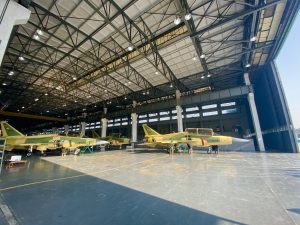The Pakistan Aeronautical Complex (PAC) Kamra completed production of the first batch of eight twin-seat Pakistan Aeronautical Complex/Chengdu Aircraft Industry Corporation (PAC/CAC) JF-17B Thunder for the Pakistan Air Force (PAF) in late December.
The aircraft were rolled out during an official ceremony held in Kamra on December 27, 2019. The rolling out of the aircraft was attended by the PAF’s chief of air staff, Air Chief Marshal Mujahid Anwar Khan, and China’s ambassador to Pakistan, Yao Jing, next to a host of other dignitaries.
According to a statement by the PAF, Khan congratulated PAC Kamra and its Chinese partners for the “successful accomplishment of [the] 2019 production target and on completing [the] first 8 dual-seat JF-17 aircraft in [a] record time of five months.”
He also noted that the JF-17 constitutes the “backbone” of the PAF and is “battle proven” as a result of combat missions conduced in February 2019 against the Indian Air Force (IAF). Pakistan at the time claimed that IAF fighters were engaged with beyond-visual-range air-to-air missiles (BVRAAM) fired from a JF-17 Block II. One Indian Mig-21 was shot down and the pilot captured.
The JF-17B aircraft will be available in an attack and trainer variant. The first prototype of the twin-seater was reportedly completed in late 2016 and made its maiden flight in April 2017. The aircraft has a deeper dorsal spine and an added fuel capacity in comparison to other one-seat JF-17 variants.
In addition to the eight aircraft rolled out in late December, the PAF expects to receive a further 14 JF-Bs in 2020 and four more in 2021, according to the chairman of the PAC.
Another variant of the aircraft, the JF-17 Block III, conducted its maiden flight on December 15 of last year.
Notably, while JF-17 Block I and II variants are reportedly powered by a Chinese license-built Klimov RD-93MA turbofan engine, the Block III version is expected to receive the RD-93MA or Chinese WS-13 engine. As I explained elsewhere:
F-17 Block III fighters will apparently receive a new electronic warfare system, upgraded avionics including a three-axis fly-by-wire digital flight control system, a helmet-mounted display and sight system, and Pakistan’s first Chinese-made active electronically scanned array (AESA) radar system. Two such radar systems are currently under evaluation, according to the PAF Air Chief: the Nanjing Research Institute of Electronics Technology’s KLJ-7A radar and the Leihua Electronic Technology Research Institute’s (LETRI) LKF601E.
Another contester reportedly is Leonardo’s Grifo-E AESA radar system. The PAF will reportedly procure at least 50 JF-17 Block IIIs by 2024.

































